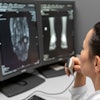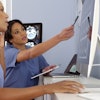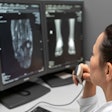
This is the second in a monthly series of coding-specific articles for U.S.-based radiology practitioners that appear each month on AuntMinnie.com courtesy of Coding Strategies Incorporated. If you'd like to offer your comments about the material, please e-mail [email protected].
By: Melody W. Mulaik
Coding Strategies
Incorporated

At the present time, approximately one-half of Medicare carriers across the country require the coding submission of the patient’s signs and symptoms, while the other half have followed The Official ICD-9-CM Coding Guidelines for Physician and Outpatient Services, published by the American Hospital Association (AHA), which require the coding of the test results.
If your practice is operating in a state that required signs and symptoms, you must be prepared to begin coding from the definitive diagnosis January 1, 2002. Coding from signs and symptoms is generally easier and faster than coding from definitive diagnoses, so expect your coders’ production to decrease slightly with these new guidelines. Also, many coders who usually code from signs and symptoms may not be as familiar with all of the diagnosis coding guidelines and will benefit from additional training to ensure correct code assignment.
The determination for payment is most often driven by the diagnosis code assignment that indicates the medical necessity of the ordered exam. Medicare carriers develop Local Medical Review Policies that define the diagnoses and conditions that they deem as medical necessities, and thus which ICD-9 codes should result in payment. (A complete listing of policies can be found at the Local Medical Review Policies Web site.)
When assigning diagnosis codes for outpatient facility and physician services, it is important to remember that documentation must be present in the radiology report for all coded conditions. The majority of radiology audits reveal far greater diagnosis coding errors than procedure coding problems. Rule-out, probable, suspected, questionable, working, and consistent with conditions may not be coded as actual conditions.
Once a diagnosis code has been submitted for payment, the payor views the information as a clinical diagnosis from the physician, and that information will remain on the patient’s record for life. No matter what role the physician has in the coding process, they are responsible for the accuracy of the information submitted on the claim form.
Change Request 1724 provides the following ICD-9-CM diagnosis coding guidance:
A. Determining the appropriate primary ICD-9-CM diagnosis code for diagnostic tests ordered due to signs and/or symptoms
- If the physician has confirmed a diagnosis based on the results of the diagnostic test, the physician interpreting the test should code that diagnosis. The signs and/or symptoms that prompted ordering the test may be reported as additional diagnoses if they are not fully explained or related to the confirmed diagnosis.
- If the diagnostic test did not provide a diagnosis or was normal, the interpreting physician should code the sign(s) or symptom(s) that prompted the treating physician to order the study.
- If the results of the diagnostic test are normal or nondiagnostic, and the referring physician records a diagnosis preceded by words that indicate uncertainty (e.g., probably, suspected, questionable, rule out, or working), then the interpreting physician should not code the referring diagnosis. Rather, the interpreting physician should report the sign(s) or symptom(s) that prompted the study. Diagnoses labeled as uncertain are considered by the ICD-9-CM Coding Guidelines as unconfirmed and should not be reported. This is consistent with the requirement to code the diagnosis to the highest degree of certainty.
Example: A patient is referred to a radiologist for an abdominal CT scan with a diagnosis of abdominal pain. The CT scan reveals the presence of an abscess. The radiologist should report a diagnosis of “intra-abdominal abscess.”
Example: A patient is referred to a radiologist for a chest x-ray with a diagnosis of “cough.” The chest x-ray reveals a 3-cm peripheral pulmonary nodule. The radiologist should report a diagnosis of “pulmonary nodule” and may sequence “cough” as an additional diagnosis.
Example: A patient is referred to a radiologist for spine x-ray due to complaints of “back pain.” The radiologist performs the x-ray, and the results are normal. The radiologist should report a diagnosis of “back pain” since this was the reason for performing the spine x-ray.
Example: A patient is referred to a radiologist for a chest x-ray with a diagnosis of “rule out pneumonia.” The radiologist performs a chest x-ray and the results are normal. The radiologist should report the sign(s) or symptom(s) that prompted the test (e.g. cough).
B. Instruction to determine the reason for the test
- A written document signed by the treating physician, which is hand-delivered, mailed, or faxed to the testing facility
- A telephone call by the treating physician or his/her office to the testing facility; and
- An electronic mail by the treating physician or his/her office to the testing facility
As specified in §4317(b) of the Balanced Budget Act ( BBA), referring physicians are required to provide diagnostic information to the testing entity at the time the test is ordered. As further indicated in 42 CFR 410.32, all diagnostic tests “must be ordered by the physician who is treating the beneficiary.”
As defined in §15021 of the Medicare Carrier Manual (MCM), an “order” is a communication from the treating physician/practitioner requesting that a diagnostic test be performed for a beneficiary. An order may include the following forms of communication:
Note: If the order is communicated via telephone, both the treating physician or his/her office, and the testing facility must document the telephone call in their respective copies of the beneficiary’s medical records.
On the rare occasion when the interpreting physician does not have diagnostic information as to the reason for the test and the referring physician is unavailable to provide such information, it is appropriate to obtain the information directly from the patient or the patient’s medical record if it is available. However, an attempt should be made to confirm any information obtained from the patient by contacting the referring physician.
C. Incidental findings
- Incidental
findings should never be listed as primary diagnosis. If
reported, incidental findings may be reported as secondary
diagnoses by the physician interpreting the diagnostic test.
D. Unrelated/co-existing conditions/diagnoses
- Unrelated and
co-existing conditions/diagnoses may be reported as additional
diagnoses by the physician interpreting the diagnostic test.
E. Diagnostic tests ordered in the absence of signs and/or symptoms (e.g. screening tests)
- When a
diagnostic test is ordered in the absence of signs/symptoms or
other evidence of illness or injury, the physician interpreting
the diagnostic test should report the reason for the test (e.g.
screening) as the primary ICD-9-CM diagnosis code. The results of
the test, if reported, may be recorded as additional
diagnoses.
F. Use of ICD-9-CM to the greatest degree of accuracy and completeness
Note: This section explains certain coding guidelines that address diagnoses coding. These guidelines are longstanding coding guidelines that have been part of the Official ICD-9-CM Guidelines for Coding and Reporting.
The interpreting physician should code the ICD-9-CM code that provides the highest degree of accuracy and completeness for the diagnosis resulting from the test, or for the sign(s)/symptom(s) that prompted the ordering of the test.
In the past, there has been some confusion about the meaning of “highest degree of specificity,” and in “reporting the correct number of digits.” In the context of ICD-9-CM coding, the “highest degree of specificity” refers to assigning the most precise ICD-9-CM code that most fully explains the narrative description of the symptom or diagnosis.
For the latest ICD-9-CM coding guidelines, please refer to the following Web site: http://www.cdc.gov/nchs/datawh/ftpserv/ftpicd9/ftpicd9.htm#guide.
In summary, the CMS memorandum states that effective January 1, 2002:
- All diagnostic tests should be coded with definitive findings (if applicable) and then signs and/or symptoms (if necessary)
- Information can be obtained from the patient if the referring physician is unavailable (but any information should be verified)
- Incidental findings should only be coded as secondary diagnoses and never primary
- Unrelated and co-existing conditions may be reported as additional diagnoses
- A screening exam is always a screening exam and all findings should be reported as secondary diagnoses
- The Official ICD-9-CM Guidelines for Coding and Reporting should be followed
If these new guidelines represent a change to your coding practices and operations, you need to get prepared immediately. Ensure your coders are adequately trained and ready to accurately assign definitive codes. Also, contact your local payor and ensure its local medical review policies have been updated to reflect appropriate definitive diagnoses, otherwise you may find numerous rejections and denials from your local carrier until its systems are updated appropriately.
Coding definitive diagnoses for outpatient and physician services has been the longstanding guideline published by the AHA. The majority of non-Medicare payors already follow these guidelines. If you have any questions regarding what your private payors require, obtain written guidance from each organization to ensure compliance with their guidelines.
By Melody Mulaik
AuntMinnie.com contributing writer
December 18, 2001
Melody Mulaik is president of Coding Strategies Incorporated. Her company will be presenting its comprehensive radiology-only workshop networking (CROWN) seminar series February 18 - 22 in Dallas. The company can be contacted at 877-626-3464 for further information.
Related Reading
Order compliance equals payment for outpatient radiologists, November 19, 2001
Copyright © 2001 Coding Strategies Incorporated



















